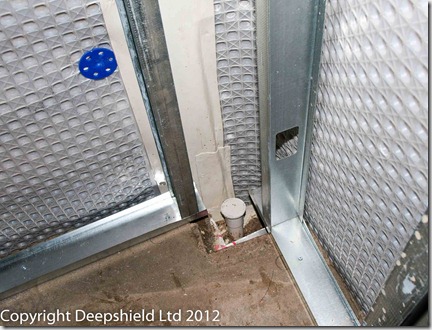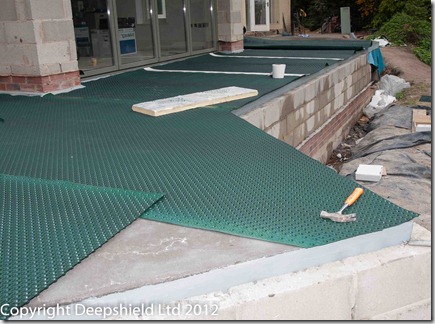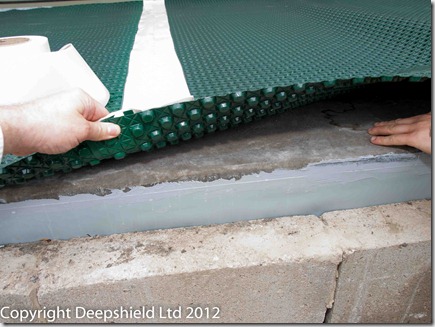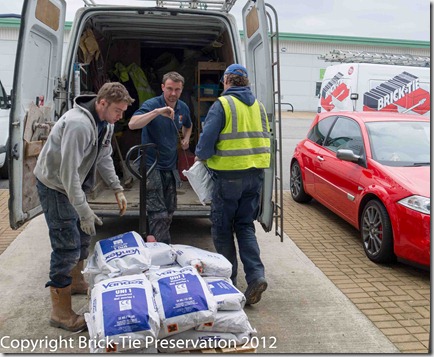On balance I’d agree that the growth of cavity drain membrane has certainly reduced the demand for Type A ‘tanked’ solutions on basement waterproofing. However, I’m seeing my purchasing of cementitious and bituminous materials growing steadily.
Of course CDM’s offer a fast and reliable way of protecting below ground structures from ground water and I am not going to argue against that – I love the stuff. Nevertheless there is a place for other methods and increasingly I find more situations where they compliment or replace the need for pumped protection.
Those of you who have CSSW (Certificated Surveyor in Structural Waterproofing), know the difference but I’ll just recap the basics for other readers;
Type C is defined in BS8102 and basically means drained protection – the water is managed rather than physically kept out of the basement. This can be by gravity drainage (if the water table is low enough and you can trust and maintain the drainage) or more commonly by pumped protection, usually using bespoke sump/pump systems like Safeguard’s excellent Sentry range.
Type A methods tend to cover external membrane protection or sometimes internal ‘tanked’ protection on new build. In existing buildings type A means tanked protection;usually cementitious or resin systems – Vandex and Sika spring to mind as the best known.
You cannot buck the market or stop natural selection (Richard Dawkins has just reaffirmed this recently), so in existing basements the tendency is for type C. The ‘egg box’ membranes like Oldroyd’s range are king now for lots of valid reasons. These include (not in any order of importance)
Speed
The membranes can be laid with minimal surface preparation; no need for shot blasting, scabbling or high pressure water jetting. With less ‘wet trade’ than multiple render coats, other than a thin finish, they offer a very fast drying out period, often being ready for decoration and occupation within days of completion.
Economy
The above prep can cost money and high specification render coats are expensive and time consuming to apply. CDM’s can be rolled over a floor like a carpet and even the wall membranes are fast to trim, fix and seal in most situations. There’s a saving here too because training needs for CDM’s is minimal, whereas there is much more technical or ‘trade’ skill needed for application of most type A products, especially renders.
Reliability
Whereas a pin hole or slight crack will kill a tanked method (though if accessible these can be fixed easily), in a CDM protected basement these will usually go unnoticed, they are very forgiving of damage and movement. They also require less skilled operatives because there are no mixing and curing protocols to mess up. Many type A products are a bit analogous to baking recipes, get the mix wrong or the application just slightly too thick or too thin and problems can occur – not so with CDM’s.
Then there’s the big one, which could come under all the above headings –
Cavity Drain Membranes have a neutral effect on the water pressure, neither reducing or increasing hydrostatic pressures (the hydraulic loads),on the existing or new structure. These pressures are there whenever there is a head of water. So if for example the water table is above floor level, there is gravity induced pressure trying to equalise the water level and fill the basement up to the water table height. The pressure is directly proportionate to the height differential and has nothing to do with the volume of water. So even if the problem is temporary and what we’d know as a ‘perched’ water table it can be quite keen to get in if the ‘head’ is high. This is an important point; The pressure in a basement with say, 1m of water above floor level, is no less than the pressure on the Great Hoover dam wall, at 1m below reservoir level, even though there are millions of gallons of water in the reservoir and maybe just a few gallons under the flower bed, below the kitchen window. Take my word; It’s useful to remember that when waterproofing a basement
So what happens if we stop the water getting in by making the wall waterproof with a type A method? The head will increase, because we have stopped the relief of pressure the previous leak provided. In effect, in changing the dynamics by stopping the water, we have changed the balance of pressures meaning:
- The pressure on the structure will increase
- Water may flow to other areas, as if attempting to relieve this pressure (it’s not intelligent but I like to think it is as I am not a scientist)
So this must be taken into account when using type A methods and this can lead to changes to the specification, skilled engineering input, maybe expensive modifications or external drainage.
What with the above you’d be forgiven in thinking that type A is dead and there’s no need to either be skilled in it’s use, or have knowledge of its strengths and weaknesses. You’d be wrong though; to take that view. Structures and site conditions vary immensely and there are so many scenarios that there is no one ‘best method’ of waterproofing them or a right or wrong way – there’s only the successful way
For example, Cavity Drain membranes are not that good when dealing with either complex shapes or soffit situations (like the concrete deck above – with a client’s games room below it); managing water is all about avoiding any head of pressure on the CDM. If water pressure comes to bear a CDM will always fail. even holding up the flow, so standing water temporarily stands on a membrane is courting disaster.
In addition, membranes and drainage can silt up or become blocked with lime scale, once more leading to failure. Maintenance costs money. Sometimes water flow can be so widespread or severe that whilst the pumps may be up to it, it can overcome the membranes’ ability to cope and then failure is a real possibility.
Thus the ability to have a way of either stopping water ingress, or slowing the flow to a manageable level is crucial and a waterproofing specialist has to know when and how this is achieved. The more skill and experience a waterproofing designer gains, the more demanding will become the contracts he/she is asked to deal with, so inevitably other waterproofing skills will be demanded and it’s a case of learn these well or suffer the loss associated with installation of a system in inappropriate circumstances.
Recently I’ve been designing waterproofing for an existing basement with something over 40,000 litres of water entering weekly. This is the result of the new-build being inadequately designed and the waterproofing being poorly executed. I won’t bore you with the details (that’s for a forthcoming case study), but as an existing basement with a floor level 4M below water table level and all this water coming in 24/7, a CDM alone would be possible, but expensive to run, with pumps operating several times a day. There’s also the environmental case for wanting to avoid pumping water into the drainage system all the time and of course the CO2 associated with continued pumping.
The answer was to specify a hybrid method, using Type A applied internally first, to reduce the water ingress to a more sedate level. Engineering advice was sought of course and some structural work was required (partially due to the poor condition of the as-built structure), before Vandex products were applied, using Vandex rapid where there was water present and Vandex Plug where the flow was high. Vandex Unimortar 1 was used to form fillets and reglets and Vandex Super on some of the new concrete. All the repairs were also overlaid with Vandex BB75 slurry. This in effect made the basement almost waterproof, so that type C Oldroyd membranes, combined with Safeguard Aqua drains and Sentry pumping stations could then be added.
This illustrates the importance of keeping an open mind on waterproofing methods. In this case a full type A ‘tanked’ solution was suggested by another waterproofing specialist, but this would have remained vulnerable to cracking in the structure and bearing in mind the doubts already raised about the quality of it, type C still offered the most reliable main waterproofing method, despite the fact that when I initially arrived on site, the basement was under 2m of standing ground water!
There are occasion where there is an existing basement with a localised leak and it’s almost always worthwhile sealing that at the point of ingress and seeing how that goes. Resin injection can also work wonders in these cases. The water may just come in at the next defect along or higher up the wall/floor, but as long as the client understands that, a local repair may save lots of time and money and may avoid a complete ‘rip-out’ or total pumped solution.
My main supplier Safeguard Europe are the UK distributors for Vandex and I’ve had my guys on their dedicated Vandex training courses. These are well worth the time and effort to attend because as I mentioned earlier, product knowledge and an appreciation of the product application and the practical subtleties of each material is essential. These are not the type of products you should just buy off the shelf and learn to use on the job.
Dry Rot.



